供应链管理作业——Zara案例分析教学提纲
ZARA成功案例分析

ZARA成功案例分析目录一、内容描述 (2)1.1 ZARA公司背景介绍 (3)1.2 研究目的与意义 (3)二、ZARA品牌定位与市场策略 (4)2.1 ZARA品牌理念与价值 (6)2.2 市场定位与目标消费群体 (7)2.3 产品策略 (8)三、ZARA供应链管理 (10)3.1 采购与供应商选择 (11)3.2 生产与物流配送 (12)3.3 库存管理与控制 (14)四、ZARA营销策略 (15)4.1 品牌推广与广告宣传 (16)4.2 社交媒体营销 (18)4.3 快速时尚趋势的把握与引领 (19)五、ZARA成功的关键因素 (20)5.1 创新能力 (21)5.2 市场敏锐度 (22)5.3 优秀的团队协作与管理 (23)六、ZARA面临的挑战与未来展望 (25)6.1 面临的挑战 (26)6.2 未来发展趋势与创新方向 (28)七、结论 (29)7.1 ZARA成功经验的总结 (29)7.2 对其他企业的启示与借鉴 (31)一、内容描述品牌定位与市场策略:分析ZARA如何准确把握消费者需求,以及其在市场策略上的创新之处,如快速响应市场变化、精准定位目标消费群体等。
产品设计与研发:研究ZARA在产品设计和研发方面的优势,以及如何通过不断创新满足消费者多样化的需求,提高产品的附加值。
供应链管理:剖析ZARA如何构建高效、灵活的供应链体系,以确保产品能够迅速投放市场并满足消费者的购买需求。
营销与推广:探讨ZARA在营销和推广方面的策略,如线上线下融合的全渠道营销、明星代言等,以及如何通过有效的营销手段提高品牌知名度和美誉度。
企业文化与管理:分析ZARA独特的企业文化和管理模式,以及如何通过人性化的管理激发员工的创造力和工作热情,从而提高企业的核心竞争力。
可持续发展与社会责任:讨论ZARA在可持续发展和社会责任方面的表现,如环保理念、劳工权益保障等,以及如何将这些因素融入企业战略,实现企业的长远发展。
ZARA案例分析(供应链)

全球门店信息每日汇总:
瑞典总部➠各部门共享门店销售记录➠ 从数据中分析顾客喜好➠准确预测➠设 计师设计➠传至采购部➠采购确定生产 数量➠供应商安排生产➠送至德国汉堡 物流中心分类➠快速配送到全球门店
ZARA和H&M供应链的的区别
ZARA:15天快速反应 H&M:双供应链平衡效率与 成本
Contents ZARA简介 ZARA供应链 H&M简介 H&M供应链
ZARA和H&M供应链的的区别
ZARA简介
• 1975年设立于西班牙的ZARA,隶 属于Inditex集团
• 目前在全球72个国家拥有1757家 专卖店
• 让平民拥抱High Fashion
ZARA-快速响应时尚
供应链简介
ZARA的全程供应馈 所有环节都围绕着目标客户运转,整个过程
不断滚动循环和优化。
以品牌为核心的协同供应链运 作模式
产品开发 • 三位一体的产品设计
• “垂直整合”的协作生产
生产制造
• “掌握最后一公里”的物流
物流配送
一站式的购物环境
专卖店直 销
H&M简介
瑞典H&M公司(HENNES & MAURITZ AB)欧 洲最大的服饰零售商。
HM以时尚、平价、质量三合一的经营 策略成功地赢得了全球消费者的青睐,成
为全球第二大时装零售商
H&M供应链
H&M拥有两条协同的供应链,分别是: 管控亚洲生产的高效供应链:常规款式的时装和童装 管控欧洲生产的快速反应供应链:量小且流行性强的
供应链管理之ZARA极速供应链分析——物流工程
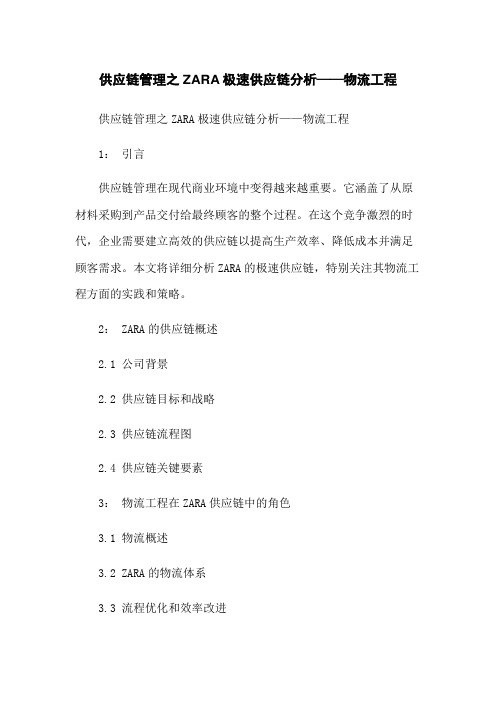
供应链管理之ZARA极速供应链分析——物流工程供应链管理之ZARA极速供应链分析——物流工程1:引言供应链管理在现代商业环境中变得越来越重要。
它涵盖了从原材料采购到产品交付给最终顾客的整个过程。
在这个竞争激烈的时代,企业需要建立高效的供应链以提高生产效率、降低成本并满足顾客需求。
本文将详细分析ZARA的极速供应链,特别关注其物流工程方面的实践和策略。
2: ZARA的供应链概述2.1 公司背景2.2 供应链目标和战略2.3 供应链流程图2.4 供应链关键要素3:物流工程在ZARA供应链中的角色3.1 物流概述3.2 ZARA的物流体系3.3 流程优化和效率改进3.4 仓储和运输管理3.5 物流技术应用4: ZARA的极速供应链实践4.1 响应市场需求的快速设计和生产4.2 高效的配送和运输网络4.3 最优化的库存管理4.4 数据分析和实时监控5:物流工程的挑战和解决方案5.1 运输成本和可持续性5.2 库存管理的复杂性5.3 供应链信息系统的整合6:法律名词及注释6.1 供应链管理6.2 物流工程6.3 运输成本6.4 库存管理7:结论通过对ZARA的供应链和物流工程的分析,我们可以看到ZARA是如何通过其极速供应链和物流战略实现高效率和敏捷性的。
然而,在这个竞争激烈的环境下,也存在一些挑战需要解决。
通过不断优化和改进物流工程,企业可以更好地应对这些挑战并保持竞争优势。
附件:本文涉及的相关数据和图表法律名词及注释:1:供应链管理:指企业在产品流通过程中,以提高资源利用效率和企业综合竞争力为目标,从供应商、生产商、分销商到终端消费者之间的有机整合与协调的一套综合性管理方案。
2:物流工程:物流工程是指通过对物品的包装、保管、运输等环节进行科学规划和有效组织,在确保物资运输过程中,提高物流的准时、快捷和安全传递的能力。
3:运输成本:运输成本是指企业在物流过程中,为完成物流活动所支出的费用,包括运输工具购买与维护费用、燃油费、人力成本等各项费用。
ZARA供应链管理案例分析
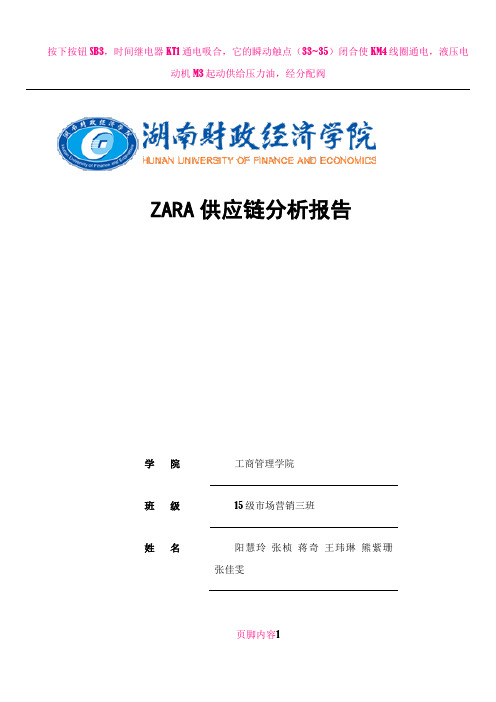
ZARA供应链分析报告学院工商管理学院班级15级市场营销三班姓名阳慧玲张桢蒋奇王玮琳熊紫珊张佳雯页脚内容1学号34 42 35 32 45 21 2017 学年第2学期页脚内容2目录一、ZARA基本概况 (3)1、品牌简介 (3)2、品牌特色 (3)3、供应链系统 (3)二、ZARA采用的供应链手段及方法 (4)1、产品组织与设计 (4)2、采购与生产 (5)3、产品配送 (6)4、终端销售和信息反馈 (6)三、从ZARA“快速”的供应链分析其成功的原因 (8)(一)一体化供应链 (8)1.“三位一体”的产品设计 (8)2.垂直整合的生产管理 (9)3.自建的高效物流体系 (10)页脚内容34.提高业务速度的信息系统和技术 (10)(二)控制节奏的供应链 (11)四:分析ZARA供应链后的感想 (12)页脚内容4一、ZARA基本概况1、品牌简介ZARA是西班牙Inditex集团旗下的一个子公司,创始于1975年,创始人是阿曼西奥·奥尔特加。
ZARA旗下拥有超过两百余位的专业设计师群,它既是服装品牌,也是专营ZARA品牌服装的连锁零售品牌。
门店遍布全球60余个国家和地区,并在2005年就名列全球100个最有价值品牌第77名2、品牌特色3、ZARA在传统的顶尖服饰品牌和大众服饰中间独辟蹊径开创了快速时尚(Fast Fashion)模式。
一年推出的商品超过12000款,每周两次的补货上架,每隔三周就要全面性的汰旧换新,全球各店在两周内就可同步进行更新完毕,极高的商品汰换率,也加快了顾客上门的回店率,因为消费者已于无形中建立起ZARA 随时都有新东西的重要形象。
4、3、供应链系统ZARA的灵敏供应链系统,大大提高了ZARA的前导时间。
前导时间是从设计到把成衣摆在柜台上出售的时间。
中国服装业一般为6~9个月,国际名牌一般可到120天,而ZARA最厉害时最短只有7天,一般为12天。
这是具有决定页脚内容5意义的12天。
现代物流与供应链案例分析-1 ZARA的极速供应链

案例分析:产品组织与设计阶段
➢ 它是从顾客需求最近的地方出发并迅速对顾客的需求做 出反应,始终迅速与时尚保持同步,而不是去预测6-9个 月后甚至更长时间的需求。
➢ 该团队不单只是设计人员而是由设计人员、市场人员、 采购和计划调度人员等跨部门的成员构成,这种人员构 成模式保证可信息快速传递、计划可执行、易执行,并 且团队不仅负责设计下季度的新产品款式,同时还不断 改进当季产品。
案例分析:产品配送阶段
➢ ZARA的各专卖店基本上采用从配送中心直配的模式, 而国内大多数服装企业都是当地设分公司建仓库,从而 也在各级中间环节积压了大量成品库存;ZARA高频、 快速、少量、多款的补货策略也保证了专卖店的出样丰 富但库存少。
➢ ZARA对各店长考核重点是预测准确率、库存周转率、 人均销售、坪效(平均每平方米的销售额或利润)和增 长率,而国内众多服装企业基本只考核销售额。
案例总结
➢ 20%的初期生产量已经足够ZARA应付新品上市时的需求 ,其余的订单是由各个网点的实时信息汇总分析而来, 这样即使前期预测失误,对于ZARA来说,20%的库存消 化起来简直不费吹灰之力。而那些过高的指望自己预测 能力的公司,一旦预测失误,他们要面对的就是永远处 理不完的库存。
➢ ZARA 的另一创新点是直接由零售网点根据本地区的需 求量向总部下订单, ZARA的店长被赋予了极大的权利 ,决定着ZARA对于本地区的需求预测。而GAP是通过订 货会汇总需求量,由于物料供应问题,通常没补货机会 。这种传统的订货会方式不仅有一定的滞后性而且容易 造成需求预测偏差,一旦产生供大于求的情况,就会发 生库存积压、产品滞销的情况,企业也无法对消费者随 时变化的需求做出快速的反应。
ZARA高效供应链的精髓
➢ 终端销售与信息反馈
供应链管理作业——Zara案例分析1.doc
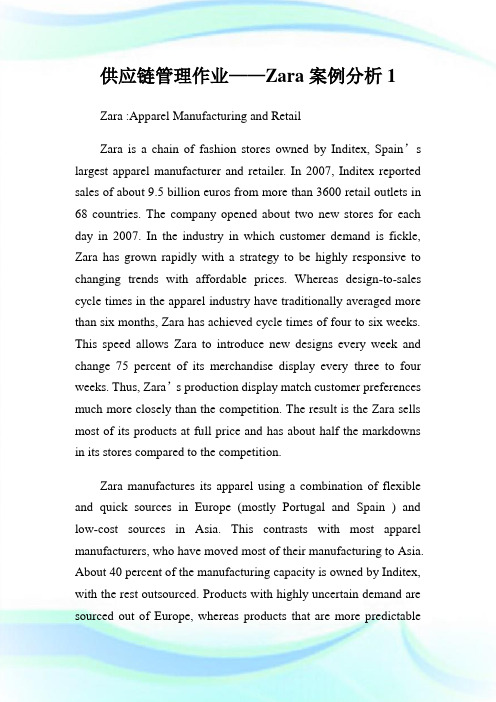
供应链管理作业——Zara案例分析1Zara :Apparel Manufacturing and RetailZara is a chain of fashion stores owned by Inditex, Spain’s largest apparel manufacturer and retailer. In 2007, Inditex reported sales of about 9.5 billion euros from more than 3600 retail outlets in 68 countries. The company opened about two new stores for each day in 2007. In the industry in which customer demand is fickle, Zara has grown rapidly with a strategy to be highly responsive to changing trends with affordable prices. Whereas design-to-sales cycle times in the apparel industry have traditionally averaged more than six months, Zara has achieved cycle times of four to six weeks. This speed allows Zara to introduce new designs every week and change 75 percent of its merchandise display every three to four weeks. Thus, Zara’s production display match customer preferences much more closely than the competition. The result is the Zara sells most of its products at full price and has about half the markdowns in its stores compared to the competition.Zara manufactures its apparel using a combination of flexible and quick sources in Europe (mostly Portugal and Spain ) and low-cost sources in Asia. This contrasts with most apparel manufacturers, who have moved most of their manufacturing to Asia. About 40 percent of the manufacturing capacity is owned by Inditex, with the rest outsourced. Products with highly uncertain demand are sourced out of Europe, whereas products that are more predictableare sourced from its Asian locations. More than 40 precent of its finished-goods purchases and most of its in-house production occur after the sales season starts. This compares with less than 20 percent production after the start of a sales season for a typical retailer. This responsiveness and the postponement of decisions until after trends are known allow Zara to reduce inventories and forecast error. Zara has also invested heavily in information technology to ensure that the latest sales data are available to drive replenishment and production decision.In 2007, Inditex distributed to stores all over the world from eight distribution centers located in Spain. The group claimed an average delivery time of 24 hours for European stores and up to a maximum of 40 hours for stores in America or Asia from the time the order was received in the distribution center(DC) to the time it was delivered to the stores. Shipments from the DCs to stores were made several times a week. This allowed store inventory to closely match customer demand. In 2007 , Inditex distributed 627 million garments globally.The following questions raise supply chain issues that are central to Zara’s strategy and success:1.what advantage does Zara gain against the competition by having a very responsive supply chain?Whereas design-to-sales cycle times in the apparel industry have traditionally averaged more than six months, Zara has achievedcycle times of four to six weeks. This speed allows Zara to introduce new designs every week and change 75 percent of its merchandise display every three to four weeks. Thus, Zara’s production display match customer preferences much more closely than the competition. The result is the Zara sells most of its products at full price and has about half the markdowns in itsstores compared to the competition.ZARA的灵敏供应链系统,大大提高了ZARA的前导时间。
Zara公司的全程供应链管理-案例分析
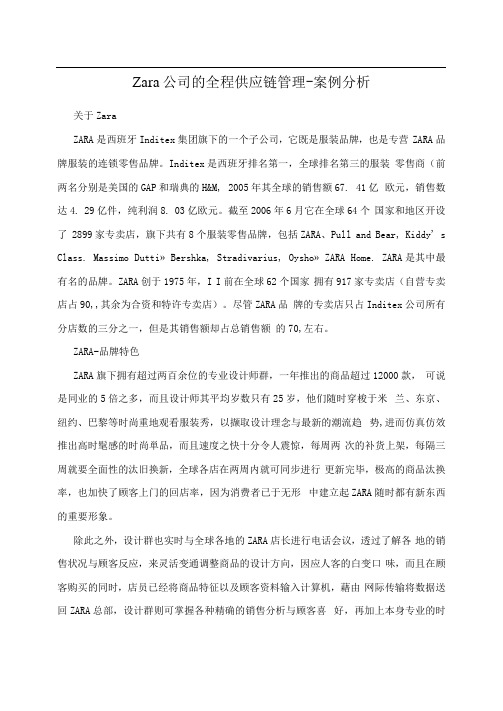
Zara公司的全程供应链管理-案例分析关于ZaraZARA是西班牙Inditex集团旗下的一个子公司,它既是服装品牌,也是专营ZARA品牌服装的连锁零售品牌。
Inditex是西班牙排名第一,全球排名第三的服装零售商(前两名分别是美国的GAP和瑞典的H&M, 2005年其全球的销售额67. 41亿欧元,销售数达4. 29亿件,纯利润8. 03亿欧元。
截至2006年6月它在全球64个国家和地区开设了 2899家专卖店,旗下共有8个服装零售品牌,包括ZARA、Pull and Bear, Kiddy' s Class. Massimo Dutti» Bershka, Stradivarius, Oysho» ZARA Home. ZARA是其中最有名的品牌。
ZARA创于1975年,I I前在全球62个国家拥有917家专卖店(自营专卖店占90,,其余为合资和特许专卖店)。
尽管ZARA品牌的专卖店只占Inditex公司所有分店数的三分之一,但是其销售额却占总销售额的70,左右。
ZARA-品牌特色ZARA旗下拥有超过两百余位的专业设计师群,一年推出的商品超过12000款,可说是同业的5倍之多,而且设计师其平均岁数只有25岁,他们随时穿梭于米兰、东京、纽约、巴黎等时尚重地观看服装秀,以撷取设计理念与最新的潮流趋势,进而仿真仿效推出高时髦感的时尚単品,而且速度之快十分令人震惊,每周两次的补货上架,每隔三周就要全面性的汰旧换新,全球各店在两周内就可同步进行更新完毕,极高的商品汰换率,也加快了顾客上门的回店率,因为消费者已于无形中建立起ZARA随时都有新东西的重要形象。
除此之外,设计群也实时与全球各地的ZARA店长进行电话会议,透过了解各地的销售状况与顾客反应,来灵活变通调整商品的设计方向,因应人客的白变口味,而且在顾客购买的同时,店员已经将商品特征以及顾客资料输入计算机,藉由网际传输将数据送回ZARA总部,设计群则可掌握各种精确的销售分析与顾客喜好,再加上本身专业的时尚敏锐度,来决定下一批商品的设计走向与数量,如此一来,商品即可发挥最大销售率,也意味着能有效压低库存的出现率。
ZARA 案例分析 供应链管理
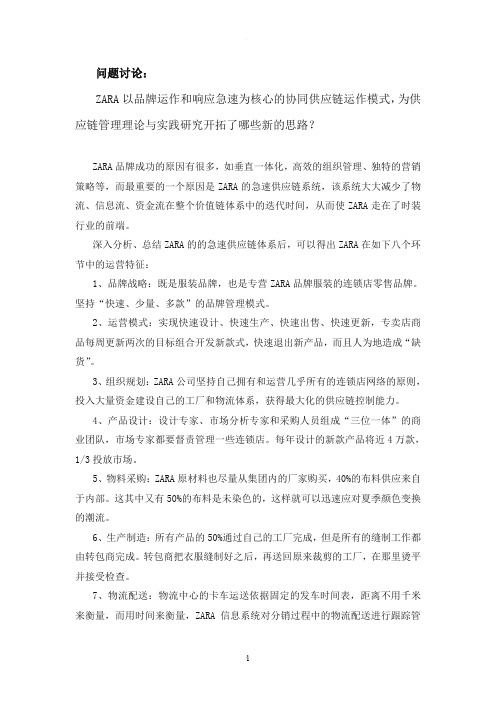
问题讨论:ZARA以品牌运作和响应急速为核心的协同供应链运作模式,为供应链管理理论与实践研究开拓了哪些新的思路?ZARA品牌成功的原因有很多,如垂直一体化,高效的组织管理、独特的营销策略等,而最重要的一个原因是ZARA的急速供应链系统,该系统大大减少了物流、信息流、资金流在整个价值链体系中的迭代时间,从而使ZARA走在了时装行业的前端。
深入分析、总结ZARA的的急速供应链体系后,可以得出ZARA在如下八个环节中的运营特征:1、品牌战略:既是服装品牌,也是专营ZARA品牌服装的连锁店零售品牌。
坚持“快速、少量、多款”的品牌管理模式。
2、运营模式:实现快速设计、快速生产、快速出售、快速更新,专卖店商品每周更新两次的目标组合开发新款式,快速退出新产品,而且人为地造成“缺货”。
3、组织规划:ZARA公司坚持自己拥有和运营几乎所有的连锁店网络的原则,投入大量资金建设自己的工厂和物流体系,获得最大化的供应链控制能力。
4、产品设计:设计专家、市场分析专家和采购人员组成“三位一体”的商业团队,市场专家都要督责管理一些连锁店。
每年设计的新款产品将近4万款,1/3投放市场。
5、物料采购:ZARA原材料也尽量从集团内的厂家购买,40%的布料供应来自于内部。
这其中又有50%的布料是未染色的,这样就可以迅速应对夏季颜色变换的潮流。
6、生产制造:所有产品的50%通过自己的工厂完成,但是所有的缝制工作都由转包商完成。
转包商把衣服缝制好之后,再送回原来裁剪的工厂,在那里烫平并接受检查。
7、物流配送:物流中心的卡车运送依据固定的发车时间表,距离不用千米来衡量,而用时间来衡量,ZARA信息系统对分销过程中的物流配送进行跟踪管理。
8、终端销售:连锁店通常每周向总部发两次订单,产品也每周更新两次。
订单必须在规定的时间之前下达,季度末会存储下季度出货量的20%。
3周不销售会退回,但控制在总数的10%以下。
总结ZARA的成功经验,我认为ZARA以品牌运作和响应急速为核心的协同供应链运作模式,为供应链管理理论和实践提供的新思路如下:1、ZARA的极速供应链是品牌导向的供应链,即供应链与品牌相互依存。
ZARA案例分析(供应链)
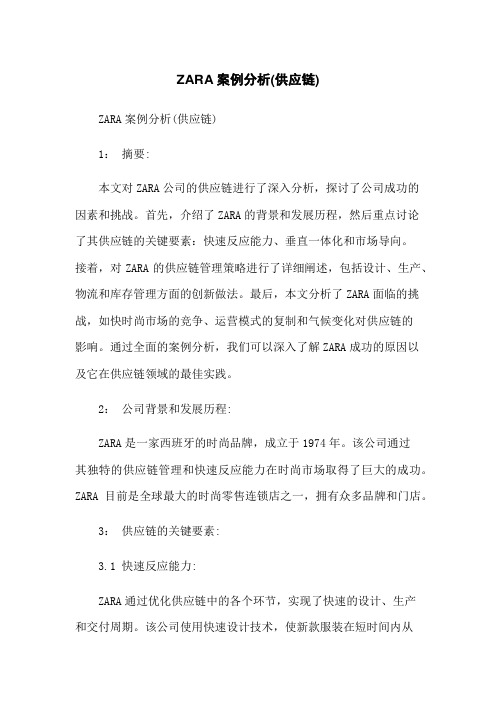
ZARA案例分析(供应链)ZARA案例分析(供应链)1:摘要:本文对ZARA公司的供应链进行了深入分析,探讨了公司成功的因素和挑战。
首先,介绍了ZARA的背景和发展历程,然后重点讨论了其供应链的关键要素:快速反应能力、垂直一体化和市场导向。
接着,对ZARA的供应链管理策略进行了详细阐述,包括设计、生产、物流和库存管理方面的创新做法。
最后,本文分析了ZARA面临的挑战,如快时尚市场的竞争、运营模式的复制和气候变化对供应链的影响。
通过全面的案例分析,我们可以深入了解ZARA成功的原因以及它在供应链领域的最佳实践。
2:公司背景和发展历程:ZARA是一家西班牙的时尚品牌,成立于1974年。
该公司通过其独特的供应链管理和快速反应能力在时尚市场取得了巨大的成功。
ZARA目前是全球最大的时尚零售连锁店之一,拥有众多品牌和门店。
3:供应链的关键要素:3.1 快速反应能力:ZARA通过优化供应链中的各个环节,实现了快速的设计、生产和交付周期。
该公司使用快速设计技术,使新款服装在短时间内从概念到上市。
此外,ZARA还通过快速反馈和信息共享来加强与供应商和合作伙伴的合作。
3.2 垂直一体化:ZARA实现了垂直一体化的供应链管理,从设计到销售的所有环节都在公司内部完成。
这种垂直一体化能够加快决策过程、提高生产效率,并保持对整个供应链的控制。
3.3 市场导向:ZARA采用市场驱动的供应链策略,及时了解顾客需求并根据市场反馈调整产品和库存。
该公司通过开设门店在核心市场,以及定期更新店内的款式和布局,为顾客提供独特的购物体验。
4:供应链管理策略:4.1 设计:ZARA的设计团队通过与市场团队的紧密合作,将时尚趋势转化为创新设计。
设计团队使用技术工具和数据分析来改进设计流程,并确保产品在品质和成本方面达到最佳水平。
4.2 生产:ZARA在全球范围内建立了自己的生产工厂,并与供应商保持紧密合作。
该公司通过生产灵活性和成本效益的平衡,实现了快速交付和高质量的产品。
ZARA案例分析供应链
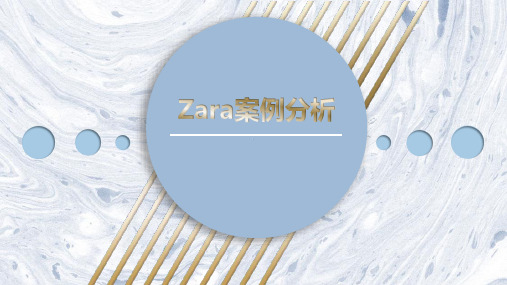
ZARA旗下拥有400余位的专业设计师,一年推出的商品超过120000款,可说是同业的5倍之多, 而且设计师其平均岁数只有25岁,他们随时穿梭于米兰、东京、纽约、巴黎等时尚重地观看服装 秀,以撷取设计理念与最新的潮流趋势,进而仿真仿效推出高时髦感的时尚单品。
每周两次的补货上架,每隔三周就要全面性的汰旧换新,全球各店在两周内就可同步进行更 新完毕,极高的商品汰换率,也加快了顾客上门的回店率,因为消费者已于无形中建立起ZARA随 时都有新东西的重要形象。
为了减少盲目生产,Zara在当季销售到来之前只生产预期出 货量的15%左右,剩下的85%的产量都是根据全球市场的销售情况 随时决策的。这属于供应链构成中的拉动式供应链,主要以客户 需求为驱动力,主张快速响应客户的需求。
Zara这种“推—拉”结合的供应链构成,可以把预测风险控制 在最低水平,减少库存积压,这样Zara由于滞销而导致的存货很 少,一般也就15%—18%。
搜寻时尚 潮流资讯
服装设计
搜集流行 布料
备料(还 布)
供应商
产品决策
染布 包装
裁布 后整工序
品质控制 物流中心
欧洲, 亚洲零 售网点
缝制(外 发厂)
美零售网 洲点
地区物流 中心
计划计计交 Nhomakorabea采
生划
交
付
购 产付
退退
退
货货
货
采购 退货
生产
交付 退货
划 采 生交
购 产付
中国服装行业供应链管理模式优化 以ZARA为例
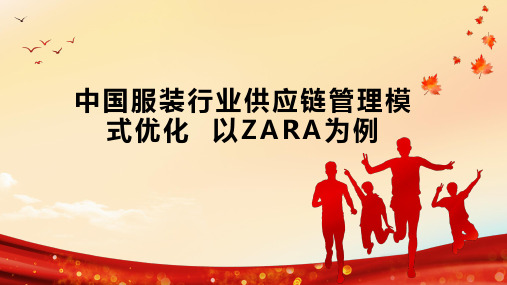
3、物流配送:ZARA建立了完善的物流配送体系
2、协同创新:服装行业上下游企业之间应加强合作,实现资源共享和优势互 补。例如,品牌商可以与供应商、物流企业共同研发新型面料和生产技术,提高 生产效率和产品质量,满足消费者需求。
3、物流配送:ZARA建立了完善的物流配送体系
3、绿色环保:随着消费者对环保意识的提高,中国服装企业应注重供应链的 绿色环保。通过选择环保材料供应商、采用环保生产技术和降低物流碳排放等方 式,实现绿色供应链管理。这不仅可以减少企业自身的环境责任风险,还可以提 高品牌形象和增加消费者忠诚度。
文献综述
文献综述
传统的服装行业供应链管理模式通常包括供应商采购、生产计划、生产控制、 物流配送等方面。然而,这种模式在面对市场变化时反应迟缓,无法满足消费者 对快速响应和个性化的需求。随着信息技术的发展,数字化供应链管理模式应运 而生。这种模式通过信息化手段实现供应链各环节的协同,提高供应链的透明度 和反应速度。
四、总结
四、总结
本次演示通过对ZARA的供应链和营销模式的分析,揭示了其成功的关键因素。 供应链的优化使得ZARA能够快速响应市场需求,而多元化的销售渠道策略使得品 牌影响力和市场份额得以提升。然而,面对不断变化的市场环境,ZARA仍需不断 创新和改进以保持竞争优势。
四、总结
展望未来,随着科技的不断进步和消费者需求的持续变化,服装品牌的供应 链和营销模式将面临更多挑战。对于服装行业来说,应更加注重供应链的透明度 和可持续性,以及营销模式的创新和差异化。借助大数据等先进技术提高生产效 率和市场预测准确性,从而更好地满足消费者需求并实现品牌的长远发展。
参考内容二
内容摘要
ZARA作为一家全球知名的服装品牌,其成功的供应链和营销模式备受业界。 本次演示将以ZARA为例,对它的供应链和营销模式进行深入分析。
供应链管理之ZARA极速供应链分析——物流工程
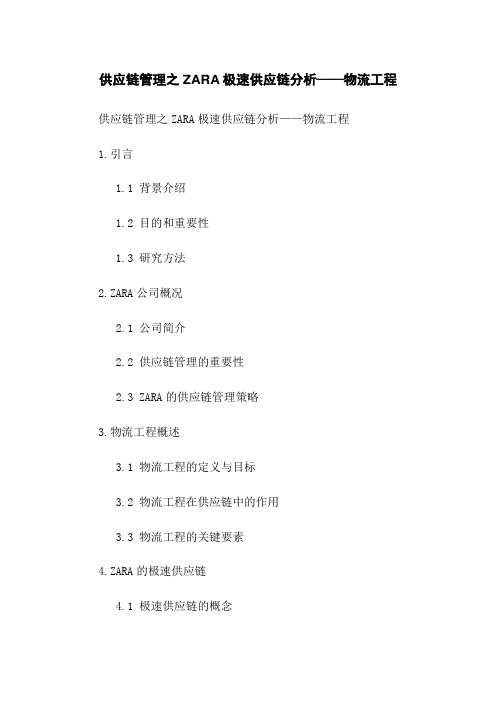
供应链管理之ZARA极速供应链分析——物流工程供应链管理之ZARA极速供应链分析——物流工程1.引言1.1 背景介绍1.2 目的和重要性1.3 研究方法2.ZARA公司概况2.1 公司简介2.2 供应链管理的重要性2.3 ZARA的供应链管理策略3.物流工程概述3.1 物流工程的定义与目标3.2 物流工程在供应链中的作用3.3 物流工程的关键要素4.ZARA的极速供应链4.1 极速供应链的概念4.2 极速供应链在ZARA中的应用 4.3 ZARA的物流网络设计4.4 ZARA的物流流程优化5.物流工程中的技术创新5.1 RFID技术在物流管理中的应用 5.2 自动化仓储系统的设计与应用5.3 在物流管理中的应用6.物流风险管理6.1 物流风险的定义与分类6.2 ZARA的物流风险管理策略6.3 供应链中的风险管理工具7.法律名词及注释7.1 遵守法律的重要性7.2 相关法律名词解释7.3 法律对供应链管理的影响8.结论8.1 研究总结8.2 对未来发展的建议附件:附件一:ZARA公司的供应链图表附件二:ZARA的物流流程图附件三:物流工程中的RFID技术应用案例附件四:自动化仓储系统设计方案本文所涉及的法律名词及注释:1.供应链:指从原材料供应到最终产品交付的整个过程。
2.物流:指从生产到消费过程中,为实现满足客户需求而进行的物品、信息和资金的流动活动。
3.极速供应链:指通过快速反应市场需求、迅速调整生产和物流的方式实现快速供应的供应链管理策略。
4.RFID:Radio Frequency Identification的缩写,即射频识别技术,用于识别和追踪物品的技术。
5.自动化仓储系统:采用自动化设备和系统管理仓储物品的系统。
Zara公司的全程供应链管理-案例分析

Zara公司的全程供应链管理-案例分析第一篇:Zara公司的全程供应链管理-案例分析Zara公司的全程供应链管理-案例分析关于Zara ZARA是西班牙Inditex集团旗下的一个子公司,它既是服装品牌,也是专营ZARA品牌服装的连锁零售品牌。
Inditex是西班牙排名第一,全球排名第三的服装零售商(前两名分别是美国的GAP和瑞典的H&M,2005年其全球的销售额67.41亿欧元,销售数达4.29亿件,纯利润8.03亿欧元。
截至2006年6月它在全球64个国家和地区开设了2899家专卖店,旗下共有8个服装零售品牌,包括ZARA、Pull and Bear、Kiddy’s Class、Massimo Dutti、Bershka、Stradivarius、Oysho、ZARA Home,ZARA是其中最有名的品牌。
ZARA创于1975年,目前在全球62个国家拥有917家专卖店(自营专卖店占90%,其余为合资和特许专卖店)。
尽管ZARA品牌的专卖店只占Inditex公司所有分店数的三分之一,但是其销售额却占总销售额的70%左右。
ZARA-品牌特色ZARA旗下拥有超过两百余位的专业设计师群,一年推出的商品超过12000款,可说是同业的5倍之多,而且设计师其平均岁数只有25岁,他们随时穿梭于米兰、东京、纽约、巴黎等时尚重地观看服装秀,以撷取设计理念与最新的潮流趋势,进而仿真仿效推出高时髦感的时尚单品,而且速度之快十分令人震惊,每周两次的补货上架,每隔三周就要全面性的汰旧换新,全球各店在两周内就可同步进行更新完毕,极高的商品汰换率,也加快了顾客上门的回店率,因为消费者已于无形中建立起ZARA随时都有新东西的重要形象。
除此之外,设计群也实时与全球各地的ZARA店长进行电话会议,透过了解各地的销售状况与顾客反应,来灵活变通调整商品的设计方向,因应人客的百变口味,而且在顾客购买的同时,店员已经将商品特征以及顾客资料输入计算机,藉由网际传输将数据送回ZARA总部,设计群则可掌握各种精确的销售分析与顾客喜好,再加上本身专业的时尚敏锐度,来决定下一批商品的设计走向与数量,如此一来,商品即可发挥最大销售率,也意味着能有效压低库存的出现率。
ZARA供应链分析
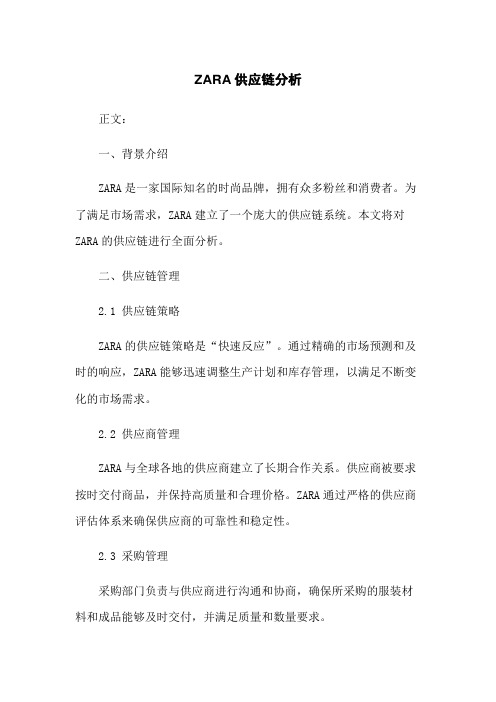
ZARA供应链分析正文:一、背景介绍ZARA是一家国际知名的时尚品牌,拥有众多粉丝和消费者。
为了满足市场需求,ZARA建立了一个庞大的供应链系统。
本文将对ZARA的供应链进行全面分析。
二、供应链管理2.1 供应链策略ZARA的供应链策略是“快速反应”。
通过精确的市场预测和及时的响应,ZARA能够迅速调整生产计划和库存管理,以满足不断变化的市场需求。
2.2 供应商管理ZARA与全球各地的供应商建立了长期合作关系。
供应商被要求按时交付商品,并保持高质量和合理价格。
ZARA通过严格的供应商评估体系来确保供应商的可靠性和稳定性。
2.3 采购管理采购部门负责与供应商进行沟通和协商,确保所采购的服装材料和成品能够及时交付,并满足质量和数量要求。
2.4 生产管理ZARA拥有自己的生产工厂,通过内部生产来控制产品质量和交货时间。
生产计划根据市场需求和销售数据进行调整,以确保产品的及时供应。
2.5 运输和物流管理ZARA建立了全球范围内的物流体系,通过与运输公司和物流合作伙伴合作,确保产品在各个销售点之间的快速运输和交付。
三、供应链优势与挑战3.1 供应链优势ZARA的供应链具有以下优势:- 快速反应能力,能够迅速调整生产和库存,以满足市场需求。
- 高质量和合理价格的产品供应,通过与可靠供应商的合作实现。
- 自有生产工厂,能够控制产品的质量和生产时间。
- 建立了全球范围的物流体系,确保产品的快速运输和交付。
3.2 供应链挑战ZARA的供应链面临以下挑战:- 快速反应策略要求高效的市场预测和及时的数据分析。
- 大规模的全球供应链需要协调和管理各个环节的供应商和合作伙伴。
- 国际贸易法律和政策的变化可能会影响供应链的稳定性和成本。
四、附件本文档的附件包括:- ZARA供应链组织结构图- 供应商合作协议范本- 运输和物流合作框架协议五、法律名词及注释本文档涉及的法律名词及其注释如下:- 供应商:指向ZARA提供服装材料和成品的企业或个体经营者。
ZARA案例分析(供应链)
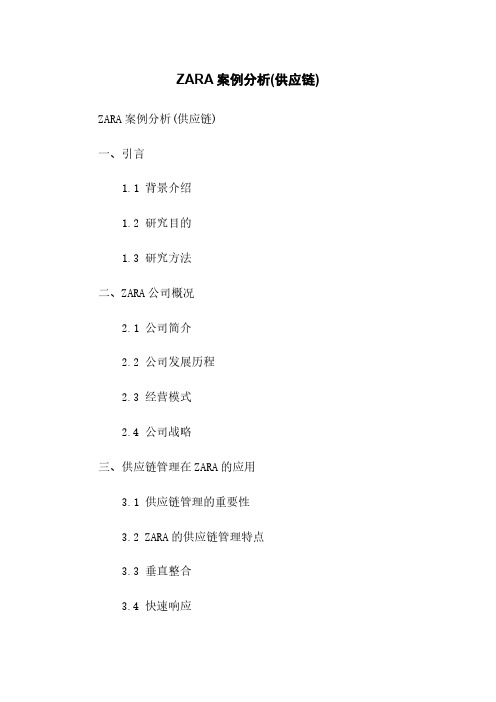
ZARA案例分析(供应链) ZARA案例分析(供应链)一、引言1.1 背景介绍1.2 研究目的1.3 研究方法二、ZARA公司概况2.1 公司简介2.2 公司发展历程2.3 经营模式2.4 公司战略三、供应链管理在ZARA的应用3.1 供应链管理的重要性3.2 ZARA的供应链管理特点3.3 垂直整合3.4 快速响应3.5 需求驱动的生产3.6 灵活的物流网络四、ZARA供应链管理的优势4.1 降低库存成本4.2 提高产品周转率4.3 缩短上市时间4.4 提高顾客满意度五、ZARA供应链管理的挑战5.1 增加供应链复杂性5.2 需要强大的信息系统支持 5.3 对供应商的高要求5.4 快速变化的市场需求六、ZARA供应链管理的应对策略6.1 投资强大的信息系统6.2 寻找合适的供应商6.3 加强内部沟通和协调6.4 不断创新和改进七、ZARA供应链管理的经验启示7.1 灵活性和敏捷性的重要性7.2 信息共享和沟通的必要性7.3 与供应商的紧密合作7.4 市场导向和顾客导向八、结论8.1 总结主要观点8.2 研究的局限性附件:1.ZARA供应链管理结构图2.ZARA供应链管理流程图3.ZARA供应链管理关键指标数据法律名词及注释:1.垂直整合:指企业将供应链中不同环节的业务纳入自己的经营范围,以提高效率和控制力。
2.快速响应:指企业能够迅速根据市场需求做出反应,例如迅速调整生产计划、快速上市新产品等。
3.需求驱动的生产:指企业通过充分了解顾客需求,根据需求进行产品设计和生产,以提高销售和顾客满意度。
4.灵活的物流网络:指企业通过建立灵活的物流网络,快速、准确地将产品送达各个销售点,以提高供应链效率和顾客满意度。
ZARA案例分析(供应链)

Inditex的首席执行官 Castellano所说:“在时 装界,库存就像是食品, 会很快变质,我们所做 的一切便是来减少反应 时间。”这就是建立第二 个物流配送中心的根本 原因。
除了销售增长使得物流 配送压力越来越大,这 还里是铁路和公路枢纽, 并且离国际机场很近, 拥有便利的交通。 时效性对于时装行业是 非常重要的。
第二个配送中心萨拉戈萨
都是在西班牙境内,对于西班 牙品牌来说,对物流配送中心
的可操控性增强。
方便互相调度人员和交通工具。
两个物流配送中心 相对位置比较近的
原因
西班牙的运输网络比较发达,无论 是空运还是其他运输模式,那里有 非常重要的交通枢纽,营运网络覆 盖率高,更适合作为全球的运输节 点。对于时效性要求高的时装行业,
在适合不过了。
在已有物流配送中心附近建立 新的配送中心,减少了市场调 研和很多其他方面的成本,需
要耗费的资金也较少。
大量的时尚观察员在搜 集最新时尚信息,并及 时向总部汇报,有设计 专家、市场分析专家和 采购人员组成“三位一
体”的商业团队。
信息收
集与产
品设计
高效的 产品组 织体系
2/周补货
口碑营 销与重 复购买
“垂直整合”的协作生产 模式是快速补货流程的支 撑力。保证了供货商能对 其订单的变化作出迅速的
反应。
高效的 物流配
送
“掌握最后一公里”的 物流配送模式是快速补
货的推动力。
第六题
信息基础设施
生产环节 配送环节 销售环节
了具有国际 先进水平的 标准化的信息系统 -------
数据库系统
CAD/CAM 系统,配置 了远程网络 计算机设计系统,剪裁设
ZARA供应链管理分析
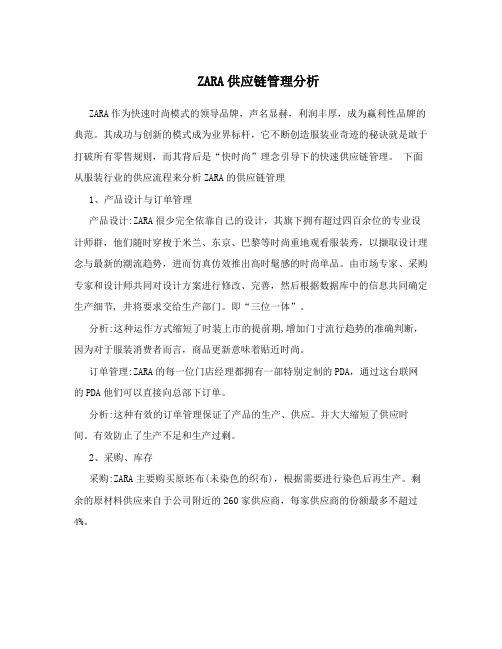
ZARA供应链管理分析ZARA作为快速时尚模式的领导品牌,声名显赫,利润丰厚,成为赢利性品牌的典范。
其成功与创新的模式成为业界标杆,它不断创造服装业奇迹的秘诀就是敢于打破所有零售规则,而其背后是“快时尚”理念引导下的快速供应链管理。
下面从服装行业的供应流程来分析ZARA的供应链管理1、产品设计与订单管理产品设计:ZARA很少完全依靠自己的设计,其旗下拥有超过四百余位的专业设计师群,他们随时穿梭于米兰、东京、巴黎等时尚重地观看服装秀,以撷取设计理念与最新的潮流趋势,进而仿真仿效推出高时髦感的时尚单品。
由市场专家、采购专家和设计师共同对设计方案进行修改、完善,然后根据数据库中的信息共同确定生产细节, 井将要求交给生产部门。
即“三位一体”。
分析:这种运作方式缩短了时装上市的提前期,增加门寸流行趋势的准确判断,因为对于服装消费者而言,商品更新意味着贴近时尚。
订单管理:ZARA的每一位门店经理都拥有一部特别定制的PDA,通过这台联网的PDA他们可以直接向总部下订单。
分析:这种有效的订单管理保证了产品的生产、供应。
并大大缩短了供应时间。
有效防止了生产不足和生产过剩。
2、采购、库存采购:ZARA主要购买原坯布(未染色的织布),根据需要进行染色后再生产。
剩余的原材料供应来自于公司附近的260家供应商,每家供应商的份额最多不超过4%。
分析:购买原胚布不仅可以迅速应对市场上花色变换的潮流,还可以有效降低原材料库存成本并防止缺货的风险。
而控制其他供应商则防止对某家供应商的依赖,同时也鼓励了供应商有更快的反应速度。
库存:ZARA有自己的信息系统对原材料进行管理,同时,在存货2方面,ZARA 的存货不超过下季度出货量20%。
分析:ZARA的供应链依靠跟精确的预测和更多即时的市场信息,反应速度比一般公司快,低存货量和精确的库存数据不仅降低了成本,同时大大提高了ZARA的核心竞争力。
3、生产管理ZARA采取垂直整合的生产管理。
供应链管理之ZARA极速供应链分析
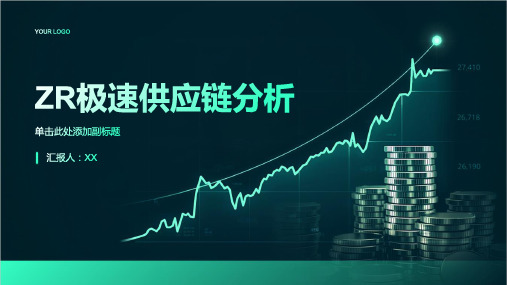
持续创新和改进
挑战:市 场竞争激 烈,消费 者需求多 变
应对策略: 持续创新, 不断推出 新产品
挑战:供 应链管理 难度大, 成本高
应对策略: 优化供应 链管理, 降低成本
挑战:环 保和可持 续发展压 力
应对策略: 采用环保 材料,提 高生产效 率,减少 浪费
技术进步对供应链的影响
物联网技术:实时监控供应链各个环节,提高效率和准确性 大数据分析:预测市场需求,优化库存管理,降低库存成本 自动化技术:提高生产效率,减少人工成本,提高产品质量 区块链技术:提高供应链透明度,降低欺诈风险,提高信任度
保持供应链的稳定性和可靠性
挑战:市场需求变化快,供应链响应速度 慢
应对策略:加强质量管理,提高供应链质 量水平
应对策略:采用快速反应系统,提高供应 链响应速度
挑战:供应链成本高,影响企业利润
挑战:供应链环节多,容易出现质量问题
应对策略:优化供应链管理,降低供应链 成本
降低成本和提高效率
采用自动化和智能化技术,提高生产效率 优化供应链管理,降低库存成本 采用快速反应机制,提高供应链响应速度 加强与供应商的合作,降低采购成本
家合作等
供应商管理: 定期评估、培
训、激励等
供应商关系: 建立良好的合 作关系,共同 应对市场变化
和挑战
库存管理与物流配送
库存管理:采用实时库存管理系 统,确保库存准确无误
配送中心:设置多个配送中心, 提高配送效率
添加标题
添加标题
添加标题
添加标题
物流配送:采用快速物流配送系 统,确保商品快速到达门店
极速供应链的概念和特点
特点:快速、灵活、高效、 低成本
背景:ZR作为全球知名的 时尚品牌,需要快速响应市
- 1、下载文档前请自行甄别文档内容的完整性,平台不提供额外的编辑、内容补充、找答案等附加服务。
- 2、"仅部分预览"的文档,不可在线预览部分如存在完整性等问题,可反馈申请退款(可完整预览的文档不适用该条件!)。
- 3、如文档侵犯您的权益,请联系客服反馈,我们会尽快为您处理(人工客服工作时间:9:00-18:30)。
Zara :Apparel Manufacturing and RetailZara is a chain of fashion stores owned by Inditex, Spain’s largest apparel manufacturer and retailer. In 2007, Inditex reported sales of about 9.5 billion euros from more than 3600 retail outlets in 68 countries. The company opened about two new stores for each day in 2007. In the industry in which customer demand is fickle, Zara has grown rapidly with a strategy to be highly responsive to changing trends with affordable prices. Whereas design-to-sales cycle times in the apparel industry have traditionally averaged more than six months, Zara has achieved cycle times of four to six weeks. This speed allows Zara to introduce new designs every week and change 75 percent of its merchandise display every three to four weeks. Thus, Zara’s production display match customer preferences much more closely than the competition. The result is the Zara sells most of its products at full price and has about half the markdowns in its stores compared to the competition.Zara manufactures its apparel using a combination of flexible and quick sources in Europe (mostly Portugal and Spain ) and low-cost sources in Asia. This contrasts with most apparel manufacturers, who have moved most of their manufacturing to Asia. About 40 percent of the manufacturing capacity is owned by Inditex, with the rest outsourced. Products with highly uncertain demand are sourced out of Europe, whereas products that are more predictable are sourced from its Asian locations. More than 40 precent of its finished-goods purchases and most of its in-house production occur after the sales season starts. This compares with less than 20 percent production after the start of a sales season for a typical retailer. This responsiveness and the postponement of decisions until after trends are known allow Zara to reduce inventories and forecast error. Zara has also invested heavily in information technology to ensure that the latest sales data are available to drive replenishment and production decision.In 2007, Inditex distributed to stores all over the world from eight distribution centers located in Spain. The group claimed an average delivery time of 24 hours for European stores and up to a maximum of 40 hours for stores in America or Asia from the time the order was received in the distribution center(DC) to the time it was delivered to the stores. Shipments from the DCs to stores were made several times a week. This allowed store inventory to closely match customer demand. In 2007 , Inditex distributed 627 million garments globally.The following questions raise supply chain issues that are central to Zara’s strategy and success:1.what advantage does Zara gain against the competition by having a very responsive supply chain?Whereas design-to-sales cycle times in the apparel industry have traditionally averaged more than six months, Zara has achieved cycle times of four to six weeks. This speed allows Zara to introduce new designs every week and change 75 percent of its merchandise display every three to four weeks. Thus, Zara’s production display match customer preferences much more closely than the competition. The result is the Zara sells most of its products at full price and has about half the markdowns in itsstores compared to the competition.ZARA的灵敏供应链系统,大大提高了ZARA的前导时间。
(前导时间是从设计到把成衣摆在柜台上出售的时间)中国服装业一般为6~9个月,国际名牌一般可到120天,而ZARA最厉害时最短只有7天,一般为12天。
这是具有决定意义的12天。
ZARA之灵敏供应链所展现出来的韵律,使得有“世界工厂”之称的中国相形见绌。
ZARA一年中大约推出120000种时装,而每一款时装的量一般不大。
即使是畅销款式,ZARA 也只供应有限的数量,常常在一家专卖店中一个款式只有两件,卖完了也不补货。
一如邮票的限量发行提升了集邮品的价值,ZARA通过这种“制造短缺”的方式,培养了一大批忠实的追随者。
“多款式、小批量”, ZARA实现了经济规模的突破。
ZARA的零售只设专卖店,那是ZARA的窗口与眼睛,不搞特许经营。
专卖店每周根据销售情况下订单两次,这就减少了需要打折处理存货的机率,也降低了库存成本。
款式更新更快增加了新鲜感,吸引消费者不断重复光顾。
快速更新店面里的货品,也确保了它们能符合顾客的品味,从而能被销售出去。
“品种少,批量大”是传统制造业的天条,而在“长尾市场”中,“款多量小”却成为当红的商业模式。
ZARA以其灵敏供应链,创造了长尾市场的新样板。
2.Why has Inditex chosen to have both in-house manufacturing and outsourced manufacturing? Why has Inditex maintained manufacturing capacity in Europe even though manufacturing in Asia is much cheaper?Products with highly uncertain demand are sourced out of Europe, whereas products that are more predictable are sourced from its Asian locations.生产基地设在西班牙,只有最基本款式的20服装在亚洲等低成本地区生产。
ZARA自己设立了20个高度自动化的染色、剪裁中心,而把人力密集型的工作外包给周边500家小工厂甚至家庭作坊,而把这20个染色、裁剪中心与周边小工厂连接起来的物流系统堪称一绝。
在西班牙方圆200英里的生产基地,集中了 20家布料剪裁和印染中心,500家代工的终端厂。
ZARA以“欧洲制造”为主要营销策略,成功切入消费者内心对“欧洲制造”等同于高级流行服饰品牌的意向,其以市场需求驱动之营销策略是成功打入市场的关键之一。
